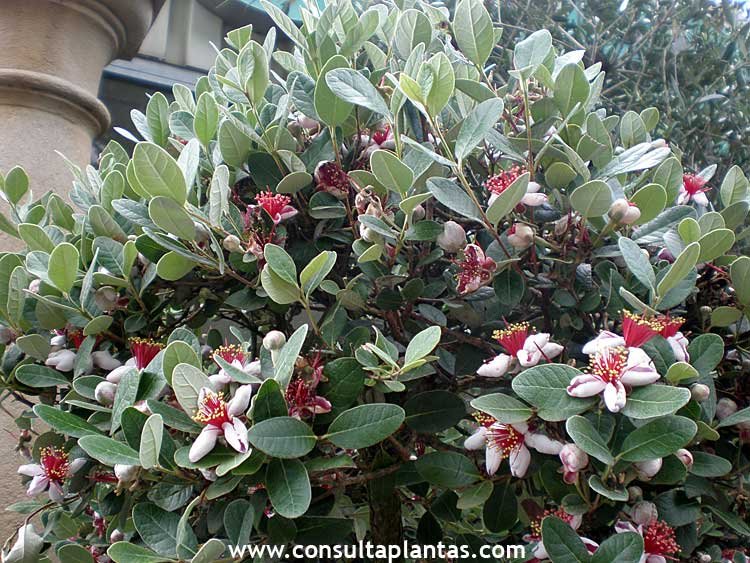Acca sellowiana
Feijoa ( Acca sellowiana ) Leaves and flowers with many stamens.
The Feijoa ( Acca sellowiana ), also feijoa or pineapple guava called, is a flowering plant in the myrtle family ( Myrtaceae ).
Description
The Feijoa is reached, a slow-growing, evergreen shrub or tree, the plant height and crown diameter of about 4 to 5 meters. The bark is light gray. The dark green, smooth, thick, elliptical leaves are white hairs on the underside, they are up to 5 cm long.
The pink, edible flowers have five bloom and many red stamens. Pollination occurs in culture, especially by bees; the nature of the stamens suggests that the wild form of Fledertieren or birds is pollinated.
The green- yellow when ripe, plum large and egg-shaped fruits in appearance, to small, pear-shaped avocados. The flesh is white and similar to the consistency of a soft pear. The highly fragrant fruit taste in the mature stage like a mixture of pineapple and strawberries, slightly tart and refreshing.
Dissemination
The Feijoa is native to the southern tropical America: southern Brazil, northern Argentina, western Paraguay and Uruguay, where it grows in the mountains.
Today, she is also in Eurasia, especially in Central Asia, terraced. Since it is a relatively undemanding plant, it is known on a large scale as a fruit in the CIS countries ( regions, inter alia, Georgia and Azerbaijan). In recent times, the plant is successfully grown in Sicily. The season of European fruit is September and October. ( Location: Adrano, Sicily) under the name Feijoa it is in New Zealand, a relatively popular garden plant. The fruits are widely available, and further processed as juice, wine or yoghurt.
Use
The ripe fruit can be eaten like a kiwi. Feijoa is suitable for the production of compote. The fruits are very well suited for the production of bread. Minced, mixed with sugar and bottled in jars, the fruit pulp holds tight in the refrigerator for many weeks. It should be emphasized is the high vitamin and iodine content of the fruit. You can freeze without loss of quality fruits and up to one year.
Care as a container plant
This type is very suitable as a container plant. The showy flowers appear on the balcony and terrace from May, under glass often sooner. The plants are not attacked by pests. Best location is a cold, tempered and warm winter- garden. It freezes at temperatures below -8 ° C.
System
You first description of this kind was made in 1854 by Otto Karl Berg in Linnaea as Orthostemon sellowianus O.Berg ( basionym ). Another synonym is Feijoa sellowiana ( O.Berg ) O.Berg. This type was introduced in 1941 by the German botanist Carl burret in Feddes Repert. Spec. Nov. Regni Veg. in the genus Acca O.Berg, as Acca sellowiana provided.

.jpg)








